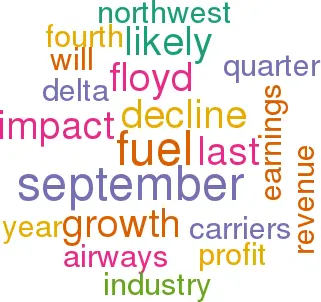Why has the US outlook suddenly changed?
October 1999


The outlook for the US airline industry has suddenly worsened. Over the past month, several major carriers have issued profit warnings and Wall Street has come out in force to revise down earnings estimates for the third and fourth quarters and for the year. The economy is doing just fine, so what’s causing the trouble?
The 4–5% decline in aggregate net earnings now expected for the September quarter is blamed primarily on higher fuel prices and a weaker domestic revenue environment. Both of these negative trends became more pronounced as the summer progressed. But while the fuel price hike was anticipated, weaker yields were not. August saw a 2.4% decline in domestic unit revenues (RASM) and analysts suggest that the September fall could be as high as 5%.
However, there is no sign of any fundamental weakening of demand. The unit revenue trends reflect fare discounting, made necessary by capacity growth, as well as the impact of two extraordinary events: last month’s Hurricane Floyd and the pilot strike at Northwest in September 1998.
PaineWebber estimates that Floyd and the absence of the traffic and yield boost enjoyed by Northwest’s competitors last year accounted for 75% of the revenue softness observed in September.
Hurricane Floyd had a devastating impact in terms of schedule disruption, as all airports from Miami to Maine were closed as the storm worked its way up the East coast during the third week of September.
According to an estimate released by Deutsche Banc Alex. Brown, Floyd cost American $25m and Delta and Continental $20m each in lost revenues. The total impact on the industry is likely to exceed $100m.
The brunt of the fuel price hike will be felt in the fourth quarter, which will now also see a decline in industry earnings. The worst–positioned are carriers like US Airways and Southwest that have not hedged their fuel costs, but others such as Delta have effectively eliminated the impact through hedging.
Capacity creeping up
Capacity growth has added to the problem, though in the summer it was running at a still–reasonable 5–6% (compared with last year’s 3.2%). But ASM growth seems to be accelerating, which makes it increasingly likely that some of the carriers will again scale back their expansion plans in the early part of the winter season.
Air traffic control delays, which surged in July–August, have also been cited as a reason for the profit decline, but the biggest problems have been self–inflicted. The best example here is US Airways, which has continued to experience a high level of cancellations because of work slowdowns by mechanics. The carrier recently warned that it does not expect to post a third–quarter profit and that the current difficulties are likely to carry over into the fourth quarter.
But there are some bright spots on the horizon. PaineWebber analyst Sam Buttrick mentions a possible near–term fare increase to mitigate fuel, likely international RASM growth, plummeting distribution costs and continued asset sales. The gradual recovery in Asia has certainly brightened United’s prospects, and the same can be said about Northwest, which is recovering nicely after last year’s strike even though it still expects a $100m loss from Pacific operations this year. News on the labour front is mixed. The tentative agreements recently reached by US Airways with its machinists and Delta with its pilots on 777 and 767–400 flying offer hope of a peaceful winter, but American and Northwest are back to square one after flight attendants rejected their tentative contracts.